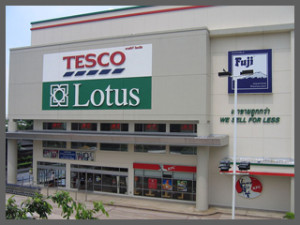 Believe it or not, Category Management is now 25 years old. First formalized by Brian Harris in 1989, Category Management has played a significant role in framing relationships between brands and retailers around the world. Like all business processes Category Management evolved in response to changes in the business environment and, as the business environment continues to evolve, so does Category Management. I believe that as we enter the next quarter century of this process’ existence we are about to see some major changes.
Believe it or not, Category Management is now 25 years old. First formalized by Brian Harris in 1989, Category Management has played a significant role in framing relationships between brands and retailers around the world. Like all business processes Category Management evolved in response to changes in the business environment and, as the business environment continues to evolve, so does Category Management. I believe that as we enter the next quarter century of this process’ existence we are about to see some major changes.
The fall of Category Management 1.0
The original 8-step process that Brian created all those years ago was designed to enable brands and retailers to work together. At its heart was the simple precept that if both could collaborate to grow the total turnover in the category, both would benefit from the increased spoils. The process help re-cast the definition and segmentation of categories based on consumer and shopper behavior and to define growth objectives based on the insights this produced. Strategies and plans to realize these objectives where the developed and, at least in theory, committed to.
I remember the first rush of enthusiasm for this process, especially from brands as it offered the potential to respond to the pressures of retail consolidation and media fragmentation by leveraging a wide retail base to market directly at the point of purchase. But over the next 15 years I also saw this enthusiasm deflate. Promised execution failed to materialize, the process was long and unwieldy and retailers proved to be fickle partners. By 2005 ‘doing Category Management’ had been reduced to horse trading over on shelf space and both brands and retailers seemed to have consigned the process to dust heap.
The rise of Category Management 2.0
And yet, the concept of working together to drive better performance at retail was far from dead. Retailers began to replace Category Management platforms with joint business planning approaches. Data from service providers such as Dunnhumby and latterly Australia’s Quantium have added a richness to this process and retailers like Tesco have continued to leverage their supplier base’s thinking by asking leading brands to share ideas to drive the category in open forums.
Concurrently, retailers themselves have taken greater initiative in develop their own category propositions and the process and science of Category Management has in general become more retailer driven. But all of this has felt very much as if the whole field is a period of transition. The major question being, in transition towards what?
The dawn of Category Management 3.0
I believe that Category Management is about to begin a major renaissance as new pressures force major retail chains to re-think their models and as brands wrestle with sluggish growth and meagre returns. The consumer goods industry has been a laggard in embracing technological changes which has often meant that in the last decade, many companies have been slow to embrace the dawn of big data but today the volume and range of available data is about to precipitate a major change in this behavior. Equally big retail is being squeezed by the advance of convenience retail, a ‘shrinking middle’ which sees discounters rising and specialty stores cream the top of the market. And the whole process of developing annual plans and long-term strategies is becoming increasingly pressurized by rapidly shifting market dynamics.
In this world we are increasingly ready for Category Management 3.0 – a new way of for brands and retailers which fully leverages today’s technology.
Category Management 3.0 will be ‘always on’
The Category Management processes of the past were ‘one shot’ projects that required extensive joint working to define a mid-range plan. The future of Category Management is one where plans are constantly refined and updated to respond to the latest data. This will more closely emulate the real world of retail where small adjustments are made constantly and targets are reviewed and recalibrated weekly, if not daily.
Category Management 3.0 will be focused on one shopper in one store
The Category Management processes of the past looked at ‘the shopper’ in ‘the store’ as if both were homogenous. In future Category Management will leverage micro-targeting of shoppers and adjust individual stores to address their needs. Oh and the ‘store’ is unlikely to be a purely physical environment as retailing bridges to online to offline world. What this means is that the shopping experience will begin to feel more personalized and tailored especially in on-line environments. This will be married with changes to physical retail environments where ranging and promotion calendars will become more responsive to geography, day part weather and the aspirations and behaviors of shoppers in the locality.
Category Management 3.0 will apply the most appropriate tools (not just the sexiest)
Category managers have always used point-of-purchase tools. In the nineties these were confined to range, merchandising, price and promotions. The category managers of the future will have a much broader set of tools influence shopper’s behavior. Some of these will be super-cool innovations but in the end they will all revolve around delivering the right product availability to the right shopper with the right message in the right media and supported by the right offer. Category managers will be able to blend tools to meet the demands of each shopper they serve. So shoppers who respond to digital tools will be served these but equally shoppers who need personal attention or just simply products that are easy to find will benefit also.
Category Management 3.0 will be machine-led
The first Category Management processes I led involved extended meetings, spreadsheet calculations and a lot of judgment and inference. This will be unsustainable in the future – data sets and complexity will exceed the processing power of humans and the limits of group work. In order to respond efficiently and effectively and constantly optimize delivery algorithmic models and machine brains will be essential. Decision making will have to become more automated which will create challenging requirements for human capital in the future. Higher levels of talent will be needed both in retail and in manufacturing and different types of skills will be become essential. Data analytics and interpretation will become key competencies in both environments as concurrently the need for creativity and strategic thinking will increase.
Category Management 3.0 requires the re-invention of brand and retail relationships
This is perhaps the area which will require the greatest level of effort from retailers and manufacturers. It may be an unfair observation to make, but I don’t believe that the last decade has hailed any improvements in the relationships between retailers and manufacturers. At best god relationships have been maintained but at worst poor relationships have deteriorated. The behaviors of both parties in the commercial transactions seem to have worsened and Tesco’s current woes serve as a clear example of the consequences of this.
For major brands and their retail customers this must change!
The commercial viability of both parties depends on their ability to service shoppers better, if they fail, shoppers will go elsewhere it’s a simple as that. Brands should be much more cognizant of the behaviors of their shoppers and the roles retailers play. Retailers should be much more aware of the value and role that brands play in enhancing shoppers’ experience. Both must embrace that retail is not a zero-sum game and that through effective collaboration profitable growth is a sustainable outcome.
New Year, new Category Management
As we enter a new year and a new quarter century of Category Management, I’m personally interested in how the industry can advance its ways of working and its utilization of technology to deliver this. I’d like to invite readers to post their thoughts and opinions on the future of Category Management and to collaborate with me to shape this change so please do get in touch.
Image from http://www.flickr.com/photos/chefranden/11675446966/in/photostream/
 It’s November! With less than two months of the year to go, Tesco’s suppliers around the world will be preparing the ground for agreeing next year’s Joint Business Plan. This year the Thailand business unit, Tesco Lotus has launched a new twist to the process, encouraging and leading manufacturers to pool their ideas. Clearly Tesco’s Thai managers hope that by gathering a category’s leading lights, they will be able to access a level of insights they have failed to tap to date. Whilst this is great for Tesco’s commercial team, many Thai trade marketers are burning the midnight oil to meet expectations!
It’s November! With less than two months of the year to go, Tesco’s suppliers around the world will be preparing the ground for agreeing next year’s Joint Business Plan. This year the Thailand business unit, Tesco Lotus has launched a new twist to the process, encouraging and leading manufacturers to pool their ideas. Clearly Tesco’s Thai managers hope that by gathering a category’s leading lights, they will be able to access a level of insights they have failed to tap to date. Whilst this is great for Tesco’s commercial team, many Thai trade marketers are burning the midnight oil to meet expectations! Ok – I admit it – I’m a category management skeptic. I wasn’t always that way, back in the early nineties I was a massive supporter – working with major retailers using a clear process which supported collaboration made loads of sense. At a time when traditional advertising was becoming less effective and marketing at the point of purchase was just beginning, I honestly thought ‘catman’ was the perfect solution.
Ok – I admit it – I’m a category management skeptic. I wasn’t always that way, back in the early nineties I was a massive supporter – working with major retailers using a clear process which supported collaboration made loads of sense. At a time when traditional advertising was becoming less effective and marketing at the point of purchase was just beginning, I honestly thought ‘catman’ was the perfect solution. I met a client in China last week who was telling me of their success in conducting category management programs with two major multi-national retailers. “The thing is, we’ve been doing this for two years and we ask ourselves, now what? Our partners are supportive but they keep challenging us to come up with something new”. I started reflecting on their options and what guidance to give.
I met a client in China last week who was telling me of their success in conducting category management programs with two major multi-national retailers. “The thing is, we’ve been doing this for two years and we ask ourselves, now what? Our partners are supportive but they keep challenging us to come up with something new”. I started reflecting on their options and what guidance to give.